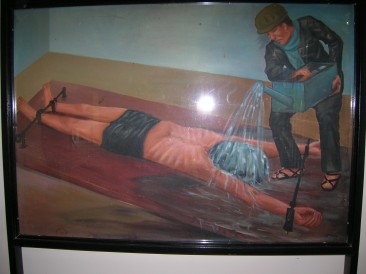Waterboarding Is Controlled Drowning
Is waterboarding torture?
My observation is that those who declare waterboarding merely harsh interrogation have not experienced it themselves. On the other hand people who have experienced waterboarding usually declare it is torture. Who do you believe?
Many hundreds in the US have experienced waterboarding as part of POW training. So far few of them have gone public about their experiences — which is a shame.
Among those who have endured waterboarding are the former associate Attorney General at the US Justice Department. He realized that the discussion on its use needed to be ground-truthed, so he subjected himself to it. It appears he came down on the side that it was torture, although his testimony is not public.
Waterboarding is usually presented as a controlled “harsh” technique, as it is reported here in a 2005 New Yorker article on training in interrigation by US special forces:
In the version used in the Navy’s SERE training program, the affiliate said,the student is bound to an inclined board, his feet higher than his head. A stream of water is then slowly poured up his nose. In SERE training, the technique is highly controlled to prevent serious physical harm (although the trainees don’t sense this).There is a strict limit of only a few cups of water per student. As an extra precaution,the trainees do jumping jacks first, to elevate their heart rate,which enables them to hold their breath for long periods during the ordeal.
But Malcolm Nance, a former SERE instructor, says this description whitewashes how severe the method really is. His article describing his own first-hand experience of the waterboarding technique cured some of my ignorance, and made me certain I did not want to experience it.
Waterboarding is a controlled drowning that, in the American model, occurs under the watch of a doctor, a psychologist, an interrogator and a trained strap-in/strap-out team. It does not simulate drowning, as the lungs are actually filling with water. There is no way to simulate that. The victim is drowning. How much the victim is to drown depends on the desired result (in the form of answers to questions shouted into the victim’s face) and the obstinacy of the subject. A team doctor watches the quantity of water that is ingested and for the physiological signs which show when the drowning effect goes from painful psychological experience, to horrific suffocating punishment to the final death spiral.
Waterboarding is slow motion suffocation with enough time to contemplate the inevitability of black out and expiration –usually the person goes into hysterics on the board. For the uninitiated, it is horrifying to watch and if it goes wrong, it can lead straight to terminal hypoxia. When done right it is controlled death. Its lack of physical scarring allows the victim to recover and be threaten with its use again and again.
The US has a long history of using waterboarding in its earlier wars. In the document Drop by Drop (PDF) published in the Columbia Journal for Transnational Law, all the references to water boarding present in court transcipts over the years have been gathered by Evan Wallach and put in a legal context. It notes:
The “water cure,” “water torture,” “water boarding;” under whatever name the technique has long been prized by extreme interrogators for its unique combination of severe
mental trauma and physical pain with, unlike other methods, a lack of perceivable physical
trauma short of autopsy.
Waterboarding is a very old technique. Many people of many races, backgrounds, and creeds have undergone it. It was a favorite technique, for example, of the Khmer Rouge in Cambodia. A former prison in Phnom Penh, now a Museum of Atrocities of the Khmer Rouge, exhibits the tools of waterboarding and a painting of how it was used. A cloth covers the face of the bound prisoner on a inclined board, head down, and water poured over the face. (Photos by Jonah Blank.)


Drop by Drop has more details on the use and experience of the technique in the US that you probably want to know: From the New York Times, 13 June, 1902.
Another witness, former Private Edward Norton “…described in one instance where he
had assisted in ‘water-curing’ a native. The man’s mouth, he said, was forced open with a stick and the water poured down his throat. The effect of the treatment was temporary strangulation. In particular case, he said, the native after receiving the cure delivered up a number of rifles and pistols.”
If that seems so long ago, yesterday the Washington Post ran an account by Richard Mezo who served in the Navy for six years in 1960s. He underwent “waterboarding” as a training exercise to prepare him for the ruthless, inhumane treatment his officers expected POWs to receive from the North Koreans. Here’s his memory of it:
I remember that the blindfold was heavy and completely covered my face. As the two men held me down, one on each side, someone began pouring water onto the blindfold, and suddenly I was drowning. The water streamed into my nose and then into my mouth when I gasped for breath. I couldn’t stop it. All I could breathe was water, and it was terrifying. I think I began to lose consciousness. I felt my lungs begin to fill with burning liquid. Pulling out my fingernails or even cutting off a finger would have been preferable. At least if someone had attacked my hands, I would have had to simply tolerate pain. But drowning is another matter.
Waterboarding has, unfortunately, become a household word. Back then, we didn’t call it waterboarding — we called it “water torture.”
Calling waterboarding torture is independent of the more complex question of whether torture is ever justified. To engage in that debate let’s just start with the truth: waterboarding is torture.
I believe YouTube videos of the practice would filter out a lot of noise. Why have we not seen any?

